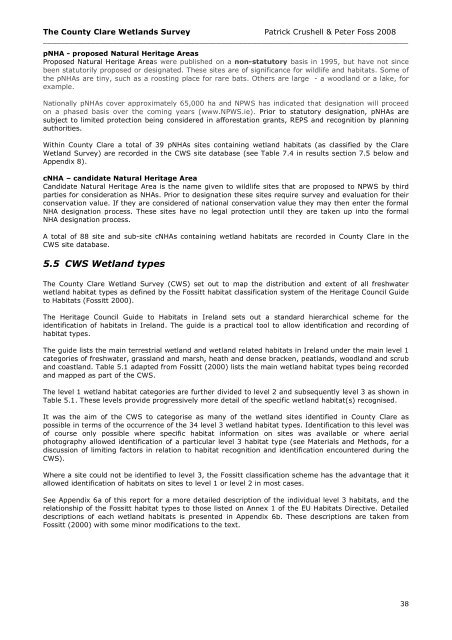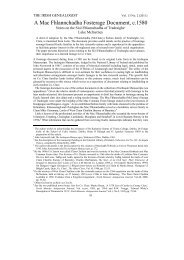Report Cover Vol I - Clare County Library
Report Cover Vol I - Clare County Library
Report Cover Vol I - Clare County Library
Create successful ePaper yourself
Turn your PDF publications into a flip-book with our unique Google optimized e-Paper software.
The <strong>County</strong> <strong>Clare</strong> Wetlands Survey Patrick Crushell & Peter Foss 2008<br />
____________________________________________________________________________________<br />
pNHA - proposed Natural Heritage Areas<br />
Proposed Natural Heritage Areas were published on a non-statutory basis in 1995, but have not since<br />
been statutorily proposed or designated. These sites are of significance for wildlife and habitats. Some of<br />
the pNHAs are tiny, such as a roosting place for rare bats. Others are large - a woodland or a lake, for<br />
example.<br />
Nationally pNHAs cover approximately 65,000 ha and NPWS has indicated that designation will proceed<br />
on a phased basis over the coming years (www.NPWS.ie). Prior to statutory designation, pNHAs are<br />
subject to limited protection being considered in afforestation grants, REPS and recognition by planning<br />
authorities.<br />
Within <strong>County</strong> <strong>Clare</strong> a total of 39 pNHAs sites containing wetland habitats (as classified by the <strong>Clare</strong><br />
Wetland Survey) are recorded in the CWS site database (see Table 7.4 in results section 7.5 below and<br />
Appendix 8).<br />
cNHA – candidate Natural Heritage Area<br />
Candidate Natural Heritage Area is the name given to wildlife sites that are proposed to NPWS by third<br />
parties for consideration as NHAs. Prior to designation these sites require survey and evaluation for their<br />
conservation value. If they are considered of national conservation value they may then enter the formal<br />
NHA designation process. These sites have no legal protection until they are taken up into the formal<br />
NHA designation process.<br />
A total of 88 site and sub-site cNHAs containing wetland habitats are recorded in <strong>County</strong> <strong>Clare</strong> in the<br />
CWS site database.<br />
5.5 CWS Wetland types<br />
The <strong>County</strong> <strong>Clare</strong> Wetland Survey (CWS) set out to map the distribution and extent of all freshwater<br />
wetland habitat types as defined by the Fossitt habitat classification system of the Heritage Council Guide<br />
to Habitats (Fossitt 2000).<br />
The Heritage Council Guide to Habitats in Ireland sets out a standard hierarchical scheme for the<br />
identification of habitats in Ireland. The guide is a practical tool to allow identification and recording of<br />
habitat types.<br />
The guide lists the main terrestrial wetland and wetland related habitats in Ireland under the main level 1<br />
categories of freshwater, grassland and marsh, heath and dense bracken, peatlands, woodland and scrub<br />
and coastland. Table 5.1 adapted from Fossitt (2000) lists the main wetland habitat types being recorded<br />
and mapped as part of the CWS.<br />
The level 1 wetland habitat categories are further divided to level 2 and subsequently level 3 as shown in<br />
Table 5.1. These levels provide progressively more detail of the specific wetland habitat(s) recognised.<br />
It was the aim of the CWS to categorise as many of the wetland sites identified in <strong>County</strong> <strong>Clare</strong> as<br />
possible in terms of the occurrence of the 34 level 3 wetland habitat types. Identification to this level was<br />
of course only possible where specific habitat information on sites was available or where aerial<br />
photography allowed identification of a particular level 3 habitat type (see Materials and Methods, for a<br />
discussion of limiting factors in relation to habitat recognition and identification encountered during the<br />
CWS).<br />
Where a site could not be identified to level 3, the Fossitt classification scheme has the advantage that it<br />
allowed identification of habitats on sites to level 1 or level 2 in most cases.<br />
See Appendix 6a of this report for a more detailed description of the individual level 3 habitats, and the<br />
relationship of the Fossitt habitat types to those listed on Annex 1 of the EU Habitats Directive. Detailed<br />
descriptions of each wetland habitats is presented in Appendix 6b. These descriptions are taken from<br />
Fossitt (2000) with some minor modifications to the text.<br />
38
















